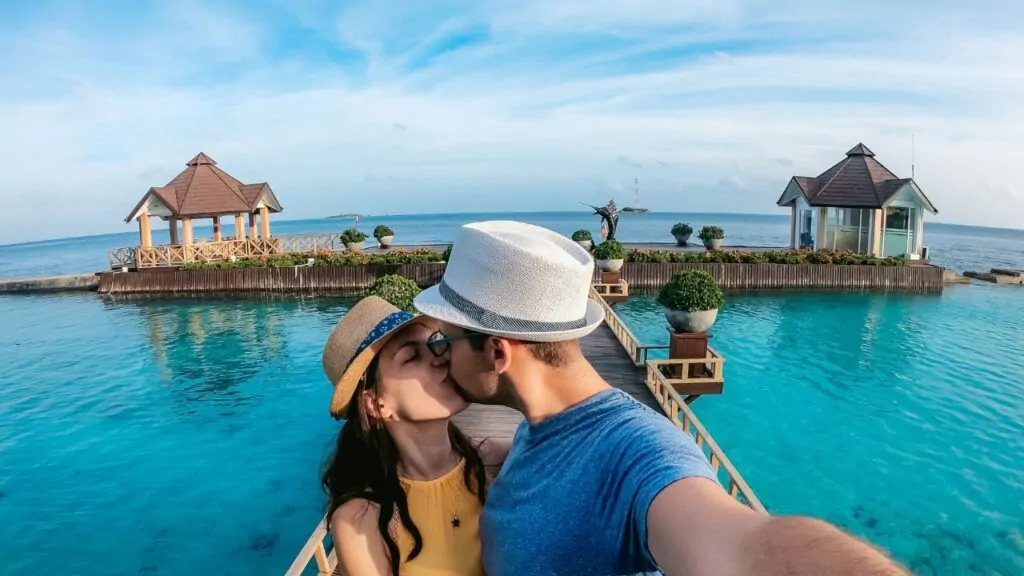There’s something incredibly magical about the beginning of a romantic relationship. Every message makes your heart race. Every touch sends shivers down your spine. You find yourself smiling at your phone like a lovesick teenager, and even their quirks—like that weird snort-laugh or obsession with pineapple on pizza—feel oddly endearing.
This period, often dreamy and passionate, is widely known as the honeymoon phase.
It’s a time when your connection feels effortless, exciting, and euphoric. The chemistry is off the charts, and you’re constantly eager to spend time with each other. You feel like you’ve finally found someone who understands you, excites you, and lights up your world.
But here’s the truth most people don’t talk about: as incredible as this phase is, it doesn’t last forever.
At some point, those butterflies settle down. That once-thrilling mystery around your partner fades a bit. You start noticing the annoying habits you previously brushed off, and slowly, the relationship moves into a new chapter—one grounded in real love and connection rather than infatuation.
But when exactly does this shift happen? What does it mean for your relationship? And most importantly, is the end of the honeymoon phase something to fear—or to celebrate?
This guide breaks it all down.
What is the Honeymoon Phase?

The honeymoon phase is the first stage in a romantic relationship, marked by heightened emotions, infatuation, sexual energy, and an overwhelming sense of excitement. During this time, both partners often idealize each other, focus on their similarities, and overlook potential flaws.
This isn’t just poetic talk—science backs it up.
Neurologically, this phase is driven by a potent cocktail of chemicals:
- Dopamine – gives you that feel-good high
- Oxytocin – the bonding hormone that makes you feel emotionally close
- Norepinephrine – heightens alertness and attention
- Cortisol – brings nervous energy and arousal
According to a 2012 study published in Social Cognitive and Affective Neuroscience, couples in early-stage romantic love show increased brain activity in the reward and pleasure centers—similar to people experiencing a drug high (Acevedo et al.).
This is why the honeymoon phase can feel so addictive. You’re intoxicated, not just emotionally, but biologically.
Why Is It Called the “Honeymoon” Phase?
The term “honeymoon” originally refers to the post-wedding vacation taken by newlyweds to celebrate their new union. This trip is usually marked by romance, closeness, and undivided attention toward one another.
Over time, the term evolved to describe any romantic period that feels like paradise—whether you’re married or not. In modern dating culture, the honeymoon phase refers to that blissful stretch early in a relationship when everything feels perfect and you can’t get enough of each other.
It’s the emotional equivalent of a romantic getaway—just without the plane tickets and hotel bills.
Why Do We Experience This Phase So Intensely?
You might wonder: why does the honeymoon phase hit us so hard and then fade away? It turns out your brain has everything to do with it.
When you meet someone new and attractive, your brain perceives them as a “reward.” This triggers a spike in dopamine, the same neurotransmitter involved in addiction. Add oxytocin and norepinephrine into the mix, and suddenly, your partner becomes the most fascinating, irresistible person on Earth.
But there’s another layer: effort.
Both people are typically on their best behavior at this stage. You dress well, you listen attentively, you say “yes” to their weird movie preferences, and you’re extra patient—even when they ramble on about their favorite video game.
This is a mix of chemical infatuation and performance—your brain and your behavior both working overtime to secure and impress a new mate.
The intensity you feel is real—but it’s also temporary.
When Does the Honeymoon Phase Start?
Most relationships enter the honeymoon phase early on—often within the first few weeks of dating. Sometimes it happens the moment you meet and feel an instant spark. Other times, it might take several hangouts, late-night chats, and inside jokes before you feel that euphoric connection.
What’s important to understand is that the start of the honeymoon phase doesn’t require a formal commitment. You can be deep in it even before you become “official.”
That magical period when you’re just getting to know each other, and every conversation feels thrilling? That’s the honeymoon phase in action.
How Long Does the Honeymoon Phase Last?

This is the golden question—and the answer varies.
On average, the honeymoon phase lasts between 6 months and 2 years, depending on multiple factors:
- How often you spend time together
- Your individual emotional needs
- Whether you live together
- How quickly you become physically intimate
- Stressful life events (e.g., work, family, finances)
- Communication patterns and conflict resolution
Fun fact: A 2005 study by Fisher et al. showed that the chemical changes associated with romantic love begin to decrease after 12 to 18 months in most couples. However, some long-term couples continue to show similar brain activity years later—especially those who report high satisfaction.
Coming Up Next
In the next sections, I’ll expand the following:
- Why some couples skip the honeymoon phase
- Detailed questions to figure out how long your honeymoon phase will last
- 53 signs the honeymoon stage is ending—with full context and explanations
- How to transition from infatuation to lasting love
- What to do if your honeymoon phase ends but you still love them
Do All Couples Experience a Honeymoon Phase?

Not necessarily. Some couples form steady, low-drama connections from the start. They may not experience fireworks—but that doesn’t mean their relationship is weak. In fact, slower-burning love often leads to longer-lasting stability.
People with secure attachment styles may skip the dramatic highs of early love but build stronger foundations over time.
How to Know If Your Honeymoon Phase is Ending
Here are key questions to ask yourself:
1. How long were you flirting or dating before becoming official?
If you were casually seeing each other for a while, your honeymoon phase might have started earlier than your official relationship.
2. Are you more relaxed around them now?
When you stop trying so hard to impress them and start showing your true self, you may be transitioning out of the honeymoon stage.
3. Are you integrated into each other’s lives?
Meeting friends, attending family events, and seeing each other’s real routines can quickly dissolve the mystery and spark.
4. How often do you see each other?
More time together can mean faster emotional progression—and a shorter honeymoon phase.
5. How physical is the relationship?
Quick sexual intimacy can fast-track emotional highs, but it may also shorten the duration of that initial thrill.
6. Are you in it just for the butterflies?
If the giddy, anxious feelings are fading and you feel bored or restless, it could be a sign the honeymoon glow is wearing off.
7. Do you still feel secure?
If you’ve stopped wondering whether they like you and feel calm about the relationship, it’s likely evolving into something deeper.
26 Subtle Signs the Honeymoon Phase is Over

- You feel more relaxed and natural around each other.
- Communication slows to a comfortable pace.
- Little quirks start to annoy you.
- Your attraction becomes less intense.
- You drop the “best behavior” mask.
- You’re okay with calling out bad habits.
- You start enjoying your alone time.
- You stop dressing up for every hangout.
- You prefer sleeping apart, not cuddling all night.
- You feel secure about where you stand.
- Sex becomes less frequent—but possibly more meaningful.
- You’re honest about your interests (e.g., “I actually hate jazz”).
- You argue more often—but also resolve better.
- Bodily functions become less taboo.
- You share more personal thoughts and goals.
- Public displays of affection decrease.
- The phrase “I love you” gets said less, but means more.
- You stop obsessing over texts or missed calls.
- You get back into your own hobbies.
- Compliments become less frequent.
- You stop fantasizing constantly about the future.
- You stop missing them every second they’re away.
- You stop idolizing their family.
- You see flaws—but still choose them.
- You don’t need constant validation.
- You realize this is real life—and still want it.
What to Do When the Honeymoon Phase Ends

It’s natural to feel confused when the initial excitement fades. But ending the honeymoon phase doesn’t mean love is fading. It’s evolving into something more grounded.
1. Reassess your feelings
Are you still happy? Do you still enjoy their company? The end of the high is a great time to evaluate how you feel now that the sparkle has dimmed.
2. Understand the root of arguments
Conflict is normal. Learn what causes friction and whether it’s something that can be worked through.
John Gottman’s research shows that how couples manage conflict—not the presence of it—predicts long-term success.
3. Normalize it
Don’t panic—every healthy relationship moves past this stage. It doesn’t mean things are falling apart.
4. Remember why you fell for them
When routines take over, revisit the moments that made you happy early on. Recreate some of those experiences.
5. Use conflict as a way to grow
Arguments aren’t always bad. They help reveal who your partner really is and how you both handle tough times.
Caughlin & Vangelisti, 2006 found that couples who engage in constructive conflict report higher satisfaction.
6. Set expectations
Talk about what you need in the relationship now. Being honest early helps prevent misunderstandings.
7. Keep communicating
If you feel things are shifting, talk about it. Discuss what’s going well and what needs attention.
8. Spice things up
Try new activities, schedule exciting dates, or change your routine to reintroduce novelty and excitement.
9. Accept their flaws
No one is perfect. Choosing to love someone includes embracing their imperfections.
10. Define your real relationship
Once the dreamy part fades, you begin to see your relationship clearly. Ask yourself—do you still choose them?
Can You Bring Back the Honeymoon Phase?

Yes! While the original intensity may not return, you can re-spark excitement through shared experiences.
According to Aron & Aron’s Self-Expansion Theory (1996), couples who try new, challenging activities together report higher passion and satisfaction.
Try These:
- Go on adventurous dates
- Plan surprise getaways
- Learn something new together
- Switch up routines in the bedroom
- Take up a hobby as a couple
Final Thoughts
The honeymoon phase is magical, but it’s not meant to last forever—and that’s not a bad thing. When it ends, it gives way to something even more meaningful: deeper trust, comfort, and long-term emotional connection.
It’s easy to love someone during the highs. But true love means choosing them even after the butterflies are gone.
So instead of fearing the end of the honeymoon phase, celebrate it. Because it means your relationship is growing into something real, lasting, and stronger than the thrill of newness.




















